Abstract
Food trade plays a key role in achieving global food security. With a growing consumer demand for diverse food products, transportation has emerged as a key link in food supply chains. We estimate the carbon footprint of food-miles by using a global multi-region accounting framework. We calculate food-miles based on the countries and sectors of origin and the destination countries, and distinguish the relevant international and domestic transport distances and commodity masses. When the entire upstream food supply chain is considered, global food-miles correspond to about 3.0 GtCO2e (3.5–7.5 times higher than previously estimated), indicating that transport accounts for about 19% of total food-system emissions (stemming from transport, production and land-use change). Global freight transport associated with vegetable and fruit consumption contributes 36% of food-miles emissions—almost twice the amount of greenhouse gases released during their production. To mitigate the environmental impact of food, a shift towards plant-based foods must be coupled with more locally produced items, mainly in affluent countries.
This is a preview of subscription content
Access options
Subscribe to Journal
Get full journal access for 1 year
119,01 €
only 9,92 € per issue
Tax calculation will be finalised during checkout.
Buy article
Get time limited or full article access on ReadCube.
$32.00
All prices are NET prices.
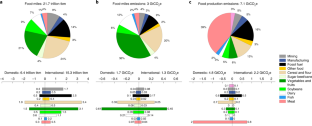
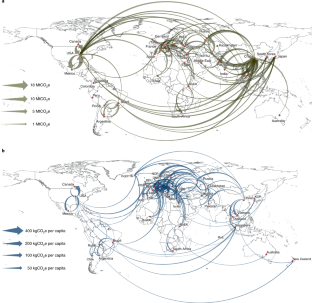
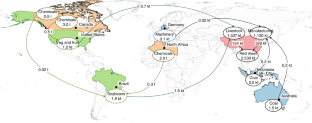
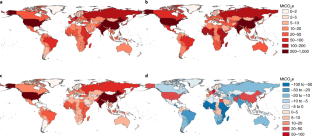
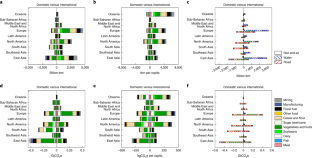

Data availability
Data supporting the findings of this study are available within the article and its Supplementary Information files, or are available from the corresponding author upon reasonable request. Source data are provided with this paper.
Code availability
The codes developed for the analyses and to generate results are available from the corresponding author on reasonable request.
References
-
The State of Agricultural Commodity Markets 2020. Agricultural Markets and Sustainable Development: Global Value Chains, Smallholder Farmers and Digital Innovations (FAO, 2020).
-
Martin, W. & Laborde Debucquet, D. in 2018 Global Food Policy Report, Ch. 3 (IFPRI, 2018); https://doi.org/10.2499/9780896292970_03
-
Porkka, M., Kummu, M., Siebert, S. & Varis, O. From food insufficiency towards trade dependency: a historical analysis of global food availability. PLoS ONE 8, e82714 (2013).
-
Porkka, M., Guillaume, J. H., Siebert, S., Schaphoff, S. & Kummu, M. The use of food imports to overcome local limits to growth. Earth’s Future 5, 393–407 (2017).
-
MacDonald, G. K. et al. Rethinking agricultural trade relationships in an era of globalization. BioScience 65, 275–289 (2015).
-
D’Odorico, P., Carr, J. A., Laio, F., Ridolfi, L. & Vandoni, S. Feeding humanity through global food trade. Earth’s Future 2, 458–469 (2014).
-
Kissinger, M. International trade related food miles—the case of Canada. Food Policy 37, 171–178 (2012).
-
Food Miles (DEFRA, 2011); http://adlib.everysite.co.uk/adlib/defra/content.aspx?id=000HK277ZX.0C90163GX9GA35
-
Andersson, K., Ohlsson, T. & Olsson, P. Screening life cycle assessment (LCA) of tomato ketchup: a case study. J. Clean. Prod. 6, 277–288 (1998).
-
Marletto, G. & Sillig, C. Environmental impact of Italian canned tomato logistics: national vs. regional supply chains. J. Transp. Geogr. 34, 131–141 (2014).
-
Wiedemann, S. et al. Environmental impacts and resource use of Australian beef and lamb exported to the USA determined using life cycle assessment. J. Clean. Prod. 94, 67–75 (2015).
-
Meisterling, K., Samaras, C. & Schweizer, V. Decisions to reduce greenhouse gases from agriculture and product transport: LCA case study of organic and conventional wheat. J. Clean. Prod. 17, 222–230 (2009).
-
Denham, F. C., Biswas, W. K., Solah, V. A. & Howieson, J. R. Greenhouse gas emissions from a Western Australian finfish supply chain. J. Clean. Prod. 112, 2079–2087 (2016).
-
Lenzen, M. Errors in conventional and input–output-based life-cycle inventories. J. Ind. Ecol. 4, 127–148 (2000).
-
Tobarra, M. A., Lopez, L. A., Cadarso, M. A., Gomez, N. & Cazcarro, I. Is seasonal households’ consumption good for the nexus carbon/water footprint? The Spanish fruits and vegetables case. Environ. Sci. Technol. 52, 12066–12077 (2018).
-
Smith, A., Watkiss, P., Tweddle, G. & McKinnon, A. C. The Validity of Food Miles as an Indicator of Sustainable Development (DEFRA, 2005).
-
Kissinger, M. International trade related food miles—the case of Canada. Food Policy 37, 171–178 (2012).
-
Neira, D. P., Fernandez, X. S., Rodriguez, D. C., Montiel, M. S. & Cabeza, M. D. Analysis of the transport of imported food in Spain and its contribution to global warming. Renew. Agric. Food Syst. 31, 37–48 (2016).
-
Mosammam, H. M., Sarrafi, M., Nia, J. T. & Mosammam, A. M. Analyzing the international trade-related food miles in Iran. Outlook Agric. 47, 36–43 (2018).
-
Pradhan, P. et al. Urban food systems: how regionalization can contribute to climate change mitigation. Environ. Sci. Technol. 54, 10551–10560 (2020).
-
Poore, J. & Nemecek, T. Reducing food’s environmental impacts through producers and consumers. Science 360, 987–992 (2018).
-
Crippa, M. et al. Food systems are responsible for a third of global anthropogenic GHG emissions. Nature Food 2, 198–209 (2021).
-
Rosenzweig, C. et al. Climate change responses benefit from a global food system approach. Nat. Food 1, 94–97 (2020).
-
Clark, M. A. et al. Global food system emissions could preclude achieving the 1.5° and 2 °C climate change targets. Science 370, 705–708 (2020).
-
Lenzen, M. et al. International trade drives biodiversity threats in developing nations. Nature 486, 109–112 (2012).
-
Oita, A. et al. Substantial nitrogen pollution embedded in international trade. Nat. Geosci. 9, 111–115 (2016).
-
Lenzen, M. et al. The carbon footprint of global tourism. Nat. Clim. Change 8, 522 (2018).
-
Janssens-Maenhout, G. et al. EDGAR v4.3.2 global atlas of the three major greenhouse gas emissions for the period 1970–2012. Earth Syst. Sci. Data Discuss. 2017, 1–55 (2017).
-
ITF Transport Outlook 2019 (ITF, 2019).
-
The Carbon Footprint of Global Trade (ITF, 2015).
-
Lenzen, M., Li, M. & Murray, S. A. Impacts of harmful algal blooms on marine aquaculture in a low-carbon future. Harmful Algae 110, 102143 (2021).
-
The Future of Food and Agriculture: Trends and Challenges (FAO, 2017).
-
Food Product Environmental Footprint Literature Summary: Food Transportation (State of Oregon, Department of Environmental Quality, 2017).
-
Wakeland, W., Cholette, S. & Venkat, K. in Green Technologies in Food Production and Processing (eds Boye, J. I. & Arcand, Y.) 211–236 (Springer, 2012).
-
Kreidenweis, U., Lautenbach, S. & Koellner, T. Regional or global? The question of low-emission food sourcing addressed with spatial optimization modelling. Environ. Modelling Softw. 82, 128–141 (2016).
-
Born, B. & Purcell, M. Avoiding the local trap: scale and food systems in planning research. J. Plan. Educ. Res. 26, 195–207 (2006).
-
Webb, J., Williams, A. G., Hope, E., Evans, D. & Moorhouse, E. Do foods imported into the UK have a greater environmental impact than the same foods produced within the UK? Int. J. Life Cycle Assess. 18, 1325–1343 (2013).
-
Pretty, J. N., Ball, A. S., Lang, T. & Morison, J. I. Farm costs and food miles: an assessment of the full cost of the UK weekly food basket. Food Policy 30, 1–19 (2005).
-
Lopez, L. A., Cadarso, M. A., Gomez, N. & Tobarra, M. A. Food miles, carbon footprint and global value chains for Spanish agriculture: assessing the impact of a carbon border tax. J. Clean. Prod. 103, 423–436 (2015).
-
Weber, C. L. & Matthews, H. S. Food-miles and the relative climate impacts of food choices in the United States. Environ. Sci. Technol. 42, 3508–3513 (2008).
-
Kinnunen, P. et al. Local food crop production can fulfil demand for less than one-third of the population. Nat. Food 1, 229–237 (2020).
-
Wood, S. A., Smith, M. R., Fanzo, J., Remans, R. & DeFries, R. S. Trade and the equitability of global food nutrient distribution. Nat. Sustain. 1, 34–37 (2018).
-
Cornwell, A. Reducing carbon dioxide emissions in Australia: a minimum disruption approach. Aust. Econ. Rev. 29, 65–81 (1996).
-
Creedy, J. & Sleeman, C. Carbon dioxide emissions reductions in New Zealand: a minimum disruption approach. Aust. Econ. Pap. 44, 199–220 (2005).
-
To Transform the Global Food System and Feed the World Sustainably, Start at the Local Level (IFPRI, 2019).
-
Pradhan, P., Lüdeke, M. K. B., Reusser, D. E. & Kropp, J. P. Food self-sufficiency across scales: how local can we go? Environ. Sci. Technol. 48, 9463–9470 (2014).
-
Kriewald, S., Pradhan, P., Costa, L., Ros, A. G. C. & Kropp, J. P. Hungry cities: how local food self-sufficiency relates to climate change, diets, and urbanisation. Environ. Res. Lett. 14, 094007 (2019).
-
Smith, A. et al. The Validity of Food Miles as an Indicator of Sustainable Development (DEFRA, 2005).
-
Godfray, H. C. J. et al. The future of the global food system. Philos. Trans. R. Soc. B Biol. Sci. 365, 2769–2777 (2010).
-
Food Systems Hold Key to Ending World Hunger (United Nations Environment Programme, 2021).
-
Tackling Climate Change through Livestock (FAO, 2014).
-
Food Loss and Waste Must Be Reduced for Greater Food Security and Environmental Sustainability (United Nations Environment Programme, 2020).
-
Fischedick, M. et al. Industry. In Climate Change 2014: Mitigation of Climate Change (eds Edenhofer, O. et al.) (Cambridge Univ. Press, 2014).
-
The Global Food System: An Analysis (World Wide Fund for Nature, 2017).
-
Spencer, S. & Kneebone, M. FoodMap: A Comparative Analysis of Australian Food Distribution Channels (Australian Government Department of Agriculture, Fisheries and Forestry, 2007).
-
Abate-Kassa, G. & Peterson, H. C. Market access for local food through the conventional food supply chain. Int. Food Agribus. Manage. Rev. 14, 63–82 (2011).
-
Sustainable Food Systems: Concept and Framework (FAO, 2018).
-
Mbow, C., et al. in Climate Change and Land: An IPCC Special Report on Climate Change, Desertification, Land Degradation, Sustainable Land Management, Food Security, and Greenhouse Gas Fluxes in Terrestrial Ecosystems (eds Shukla, P. R. et al.) Ch. 5 (2019).
-
Leontief, W. Input–Output Economics (Oxford University Press, 1966).
-
Lenzen, M., Moran, D., Kanemoto, K. & Geschke, A. Building Eora: a global multi-region input–output database at high country and sector resolution. Econ. Syst. Res. 25, 20–49 (2013).
-
Lenzen, M., Kanemoto, K., Moran, D. & Geschke, A. Mapping the structure of the world economy. Environ. Sci. Technol. 46, 8374–8381 (2012).
-
Lenzen, M. et al. The Global MRIO Lab—charting the world economy. Econ. Syst. Res. 29, 158–186 (2017).
-
National Accounts Main Aggregates Database (United Nations Statistics Division, 2020); https://unstats.un.org/unsd/snaama/
-
National Accounts Official Data (United Nations Statistics Division, 2019); http://data.un.org/Browse.aspx?d=SNA
-
Industrial Statistics Database at the 4-digit Level of ISIC (INDSTAT4) (UNIDO, 2019); http://www.unido.org/resources/statistics/statistical-databases.html
-
UN Comtrade—United Nations Commodity Trade Statistics Database (United Nations Statistics Division, 2019); http://comtrade.un.org
-
UN ServiceTrade (United Nations Statistics Division, 2019); https://unstats.un.org/unsd/servicetrade/default.aspx
-
FishStat—Software for Fishery and Aquaculture Statistical Time Series (FAO, 2017).
-
Geschke, A., Ugon, J., Lenzen, M., Kanemoto, K. & Moran, D. D. Balancing and reconciling large multi-regional input–output databases using parallel optimisation and high-performance computing. J. Econ. Struct. 8, 2 (2019).
-
Lenzen, M., Gallego, B. & Wood, R. Matrix balancing under conflicting information. Econ. Syst. Res. 21, 23–44 (2009).
-
Food Products Imports by World 2018 (WITS, 2018); https://wits.worldbank.org/CountryProfile/en/Country/WLD/Year/2018/TradeFlow/Import/Partner/all/Product/16-24_FoodProd
-
FAOSTAT Database (FAO, 2018).
-
Hall, O., Bustos, M. F. A., Olén, N. B. & Niedomysl, T. Population centroids of the world administrative units from nighttime lights 1992−2013. Sci. Data 6, 235 (2019).
-
Goods Transport (ITF, 2017); https://www.oecd-ilibrary.org/content/data/g2g5557d-en
-
Elvidge, C. D. et al. Relation between satellite observed visible-near infrared emissions, population, economic activity and electric power consumption. Int. J. Remote Sens. 18, 1373–1379 (1997).
Acknowledgements
This work was financially supported by the Australian Research Council (projects DP0985522, DP130101293, DP190102277, LE160100066, DP200102585, DP200103005, LP200100311, IH190100009) and the National eResearch Collaboration Tools and Resources project, through the Industrial Ecology Virtual Laboratory infrastructure VL 201. We thank S. Juraszek for expertly managing the Global IELab’s advanced computation requirements, and C. Jarabak for help with collecting data
Author information
Authors and Affiliations
Contributions
M. Lenzen designed the study. M. Li conducted the analyses. M. Li, L.W., N.J. and Y.J. contributed to data collection. M. Li, D.R., M. Lenzen and A.M. wrote the paper. All authors contributed to data interpretation and manuscript editing.
Corresponding author
Ethics declarations
Competing interests
The authors declare no competing interests.
Peer review
Peer review information
Nature Food thanks Prajal Pradhan, Pekka Kinnunen and the other, anonymous, reviewer(s) for their contribution to the peer review of this work.
Additional information
Publisher’s note Springer Nature remains neutral with regard to jurisdictional claims in published maps and institutional affiliations.
Supplementary information
Supplementary Information
Supplementary Tables 1–6 and Figs. 1–12.
Supplementary Data
Australian National Accounts: Input–Output Tables
Source data
Source Data Fig. 2
Source data for Fig. 2.
Source Data Fig. 4
Source data for Fig. 4.
Source Data Fig. 5
Source data for Fig. 5.
Source Data Fig. 6
Source data for Fig. 6.
Rights and permissions
About this article
Cite this article
Li, M., Jia, N., Lenzen, M. et al. Global food-miles account for nearly 20% of total food-systems emissions. Nat Food (2022). https://ift.tt/c27nYkP
-
Received:
-
Accepted:
-
Published:
-
DOI: https://ift.tt/c27nYkP
https://ift.tt/op62DQr
food

Tidak ada komentar:
Posting Komentar